![]()
The Words of the Stovall Family
|
|
The Words of the Stovall Family |
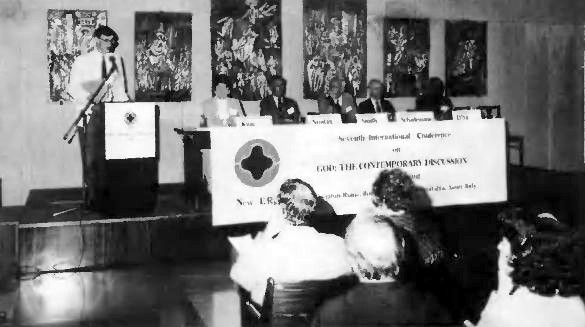
Dr.
Franz Feige, Executive Director of New ERA, welcomes the
participants.
On May 1, 1990 approximately 70 people arrived in Rome, Italy to attend the seventh conference on "God: The Contemporary Discussion" sponsored by the New Ecumenical Research Association (New ERA), a project of the International Religious Foundation.
This conference was different from the previous six conferences in the following way: The conference was held in two locations, Rome and Assisi; it was smaller, about 60 participants; it had only one theme, "God and God-Equivalents"; and the format was enriched through a plenary speech and a panel discussion.
The conference started at the Sheraton Roma Hotel in Rome on May 1, with a very warm welcome reception where many old friends were able to meet one another again, surrounded by Roman pillars and marble statues. For those who were attending for the first time, new friends were quickly made. Dinner followed the reception and then a welcoming address was given by Dr. Francis D'Sa, the Conference Chairperson and Dr. M. Darrol Bryant, the Conference Convener. Dr. Franz Feige, Executive Director of New ERA, also welcomed the participants on behalf of New ERA and IRF.
The following morning began with an early start as the participants were taken on a brief tour of either the Vatican, at which many people wanted to see the renovated Sistine Chapel, or the Roman Forum and the Coliseum. Following the tour, the participants were then driven to Assisi where the rest of the conference was held from May 2-7, 1990. We stayed at La Cittadella Ospitalita, which is a conference center run by lay Franciscans.
Since the participants had met each other the previous day we were able to start the conference discussions before dinner. As there was only one theme, the participants were divided into three groups so that the topic could be discussed in more detail. Prior to the conference, Dr. Francis D'Sa wrote a statement on "God and God-Equivalents" [See next page.] and each participant was asked to focus his/her paper on the statement from their own tradition, or studies.
As an example Dr. D'Sa asked "Does God equal Allah or is Brahman equivalent to Tao? If so in what sense? Or do these words mean radically diverse "ultimates?"
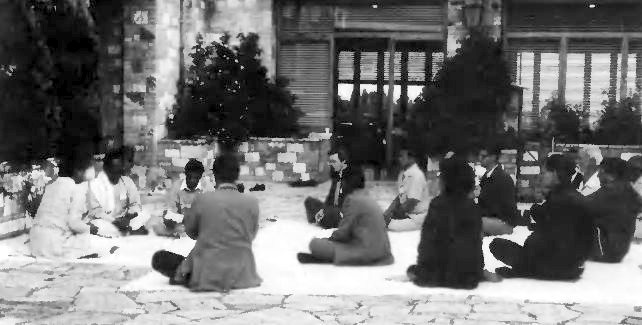
The
Buddhist morning service included a lesson in yoga exercises.
In order to help us understand the other traditions more, prayer/meditation services were held each morning. All the services with the exception of the Jewish service were held out on a terrace which overlooked the valley towards Santa Maria Degli Angeli, which is the site of the Porziuncola, the little chapel St. Francis rebuilt with his own hands. It is also where St. Francis discovered his true spiritual vocation, where he obtained the famous "Indulgence of Assisi," and where he died on the evening of October 3, 1226.
On the first morning in Assisi a Christian Service was held; the following morning was a Buddhist Service during which we also learnt how to do certain yoga exercises. The Jewish service was a very warm and lively service which invited a lot of response from the participants. The final service was a Hindu service. During all the services, it was wonderful to see people from all traditions and faiths joined together in worship.
Dr. Ewert Cousins gave a plenary speech on "Francis of Assisi and Inter-religious Dialogue." Dr. Cousins is a well-known scholar who has translated a biography of St. Francis written by Bonaventure, a medieval theologian. During his speech he was able to give us a detailed description of St. Francis' life in and around Assisi and how it led to inter-religious dialogue. Father Antonio, the community priest of La Citt della Ospitalita, remarked during the conference that St. Francis would have felt truly happy to see so many people from different traditions meeting and talking together as we were.
Aside from giving his plenary speech Dr. Cousins also acted as a tour guide for many of the participants during the afternoon free-time, at which they were able to continue with their discussions on God and God-Equivalents and Inter-religious Dialogue. For many it was a pilgrimage to visit the many sites of Assisi, for others it was a time to enjoy the peace which pervaded the air and allowed one to sit and meditate looking out over the rose colored city or the green valley below.
As stated earlier, a panel discussion was also presented on the "Future of God." The presenters were the past God Conference Chairpersons: Dr. Frederick Sontag, Dr. Huston Smith, Dr. Robert Scharlemann and the present chairperson, Dr. Francis D'Sa. Each person gave a very different view on the topic. Dr. Ursula King moderated the session.
On the final day a short closing ceremony was held at which each group gave a brief summary of their discussions during the conference. It was noted throughout the conference that one group in particular was forever in gales of laughter. We did wonder if they had been able to have any serious discussions but we were relieved to hear that the laughter had only enhanced their discussions and many barriers had been broken by this.
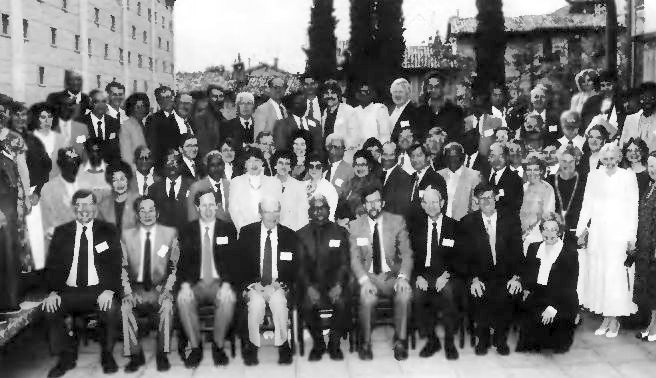
Conference
participants gather for the group photo outside La Cittadella
Ospitalita.
This ceremony was followed by dinner and evening entertainment. The evening entertainment was presented by three people playing music on instruments from the medieval period. To give it an authentic flair, the Ensemble were all wearing medieval costumes. The entertainment began with a flourish with Ensemble being trumpeted in. They continued to keep us entertained, with our feet tapping away, as we marveled at the musicians' ability to play so many different instruments, many of them at the same time. The audience was so enthralled that many were heard to say that they wanted to get up and dance. It was not surprising that the Ensemble received a standing ovation at the end.
After the entertainment an international Jesuit scholar, Salvino Azzopardi, went up to Dr. Feige and flung his arms around him, exclaiming, "I have never experienced anything like this. This has not been a conference. This has been an incomparable experience. Even we Jesuits could not do this."
The next morning came very early for many as they left to go back home following many wonderful experiences, new friendships, and new ideas. It was a time for hugs, and tears for some, as we waved our goodbyes. Many went home with a renewed vision of how they could teach their students of the things they had learnt from one another during the conference.
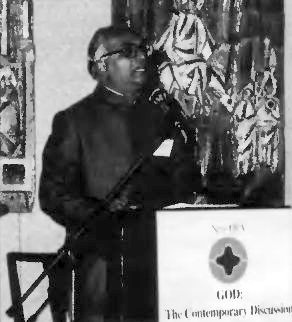
Dr.
Francis D'Sa, Conference Chairperson
We are aware that the theme for this Seventh Conference on "God: The Contemporary Discussion" -- "God and God-Equivalents" -- might seem to exclude those traditions in which this "God way" of naming or conceptualizing the Ultimate is either not found, or is not central. But that is not our intention. Any statement must be formulated in some language and thus bears the ambiguities of that language. We trust that you will be assured that we do not wish, by this statement, to exclude anyone from the discussion. Rather we want to explore a certain direction in inter-religious encounter and dialogue and thus we request that you take this statement in an inclusive way.
When believers attempt to give an account of their faith-experience they all have to face the same fact, irrespective of the tradition they might come from: the articulation of their experience can never keep pace with the experience itself. However intimately experience may be connected to and related to its immediate expressions, the latter always lags behind the former. Hence no "enlightened" believer could seriously identify belief-articulation with faith-experience. Indeed though the identity of a belief hangs together with its articulation aspect, the belief itself embodies a depth-dimension experience which is in fact an experience of Transcendence. In other words, whereas belief is the identifiable aspect of this experience, the experience is in fact the touch of Transcendence. When Transcendence touches us we express this touch in the "form" of a belief. This "shapes" the whole belief-system of the believer. The result is that all his/her beliefs reflect this form which gives consistency to the different beliefs and to the diverse interpretations of those beliefs.
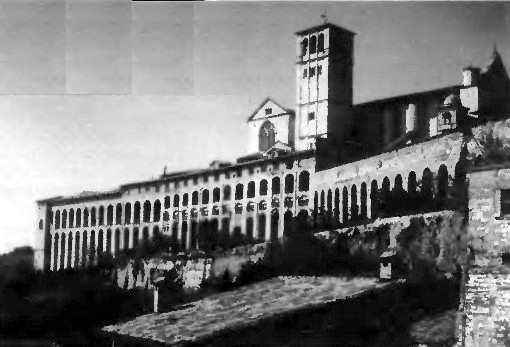
The
Basilica of St. Francis in Assisi, where St. Francis is buried.
Religious traditions usually give a name to this form of the beliefs in such a manner that this name dominates the life and practices of the respective traditions. Thus we have Yahweh Theos in the Judeo-Christian traditions, Allah in Islam, Sri-bhagavan in the Hindu traditions, Nirvana in the Buddhist, and so on. A name like this is not a mere name like Tom, Dick, or Harry. It is both the center and the circumference of a definite world. A whole new world is defined by such a name and only one who has entered it, lives, moves and has his/her being in it, understands it.
From such an understanding emerges a family of equivalents which are but different aspects of the diverse experiences of the Name that defines a tradition. Thus we have for God, Father, Trinity, Lord Creator, and so on in the Christian traditions. In the Hindu traditions we have, for example, Ishvara, Parameshvara (and others like Yogeshvara), Purnam, Sarvam, Puruscha, Puruschottama and Paramartha. Obviously these are just "intra-traditional" equivalents and are meaningful within the context of their respective traditions. Now some of these equivalents, I suggest, could lend themselves to an "inter-traditional" equivalence.
Take for instance, the designation Paramartha which is a compound of Parama (highest, supreme, ultimate) and artha (reality, meaning, goal) and so could be rendered as "ultimate meaning." Probably no tradition would deny that its Supreme Name is the Ultimate Meaning for its believers since no other name can be really a supreme name if it is not ultimately meaningful. Though understood differently by different traditions, ultimate meaning could be meaningful to other traditions as well. One could, I am convinced, work out a position which indicates how the name Paramartha could be meaningfully integrated into or developed from the Supreme Name of (at least) some traditions.
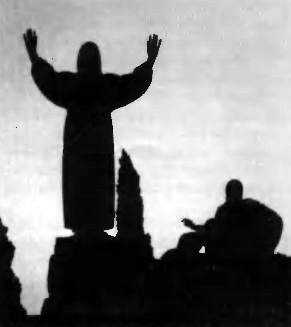
Statue
of St. Francis, during his visit to Rome, supplicating the Pope.
What is the point of discovering and developing such equivalents?
The main purpose would be to search for not yet tried out paths leading into inter-religious understanding. It could be possible that on the basis of the one world and the one humanity to which we all belong we could also discover multiple paths to the one final fulfillment of the world of human beings. It is possible, for instance, that the multiple paths of the respective religious traditions actually point in the same direction, the sameness of direction being identified by common facts like the perpetual and invincible lag between experience and expression on the one hand and by "common" names like Paramartha on the other.
If this were possible, our task would be to search in our own traditions for such equivalents that would eventually make sense to and in other traditions too.